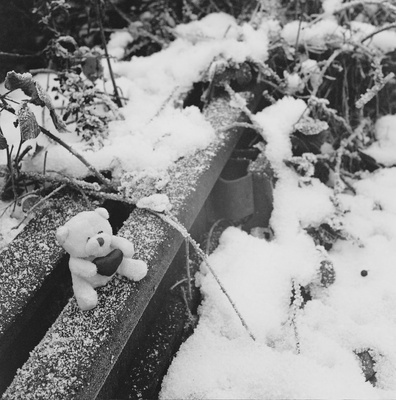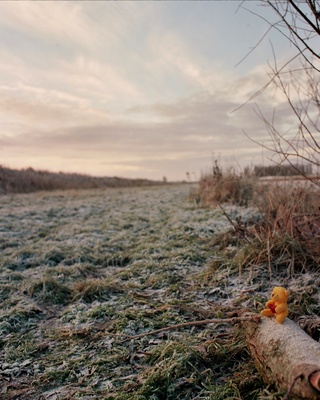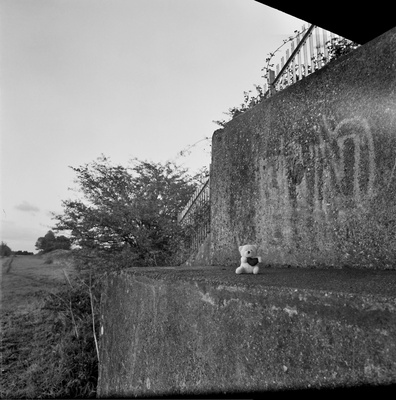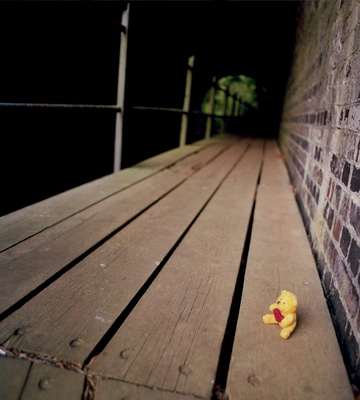
Kiev 88, serial #9702694 (indicating a 1997 manufacturing date) and a Mir 26B 45mm f/3.5.
from Shutter, by Lewis Collard
This article was written in 2011.

Kiev 88, serial #9702694 (indicating a 1997 manufacturing date) and
a Mir 26B 45mm f/3.5.
This is the Kiev 88, a bad Ukrainian copy of a medium-format Hasselblad film SLR camera.
This is not a camera for the faint-hearted. It is not even a camera for someone that needs their camera to work when they ask it to. It has ergonomics from the 1940s. It is big and heavy. It is crudely-assembled and capricious. Nevertheless, in the hands of a good photographer (rather than some guy with a website) the Kiev 88 is capable of big things, and is one of the cheapest ways to get into medium-format photography.
Mine has a TTL meter, through a gigantic add-on pentaprism. I bought it assuming that the meter would not work properly, and it didn't. Recalibrating it would be simple, except that it's not consistently inaccurate; it's roughly right at around EV 5, gives about a stop underexposure in overcast weather outdoors, and is out by about two (!) stops in bright daylight.
I'm not bothering with the TTL meter as I write this; it's less work to carry around a tiny plastic Pentax ZX-M or Nikon F55 in the copiously large pockets of my combats as a meter.

Tiny teddy waits for
a train. Kiev 88 and Arsat (pronounced "Arsehat") 80mm f/2.8, 1/30
at about f/8, Kodak BW400CN.
The Kiev has a metal, mechanically-controlled horizontal-travel focal-plane shutter. It works from 1/1000 to 1/2 sec, plus Bulb. Avoid the very slowest speeds on this camera, because they are unreliable. If you're in low light and need these slower speeds, stop down for a two- or three-second exposure, use B and count the seconds in your head.
Flash sync is a mere 1/30, which is slower than any other camera I own.
There is no self-timer.

Shrooms. Kiev 88 and Mir-26B 45mm f/3.5,
1/60 at f/5.6, Kodak Ektar 100.
The Kiev 88 is mostly metal. It weighs a ton with the marginally-useful TTL pentaprism. It feels (at least until you actually use it) like a big, tough camera. However!

Fallen branch. Kiev 88 and a lens I
can't remember shooting Kodak Ektar 100.
Pretty much what you'd expect from a bad copy of a 1940s/1950s camera which was then made in a Soviet armaments factory in Ukraine on a budget of about 20 pence. They are so badly-built that its adoring fans call them "the worst cameras in the world", and talk about the wonderful things that can be done with them "if you are actually able to coax one of them into working" -- possibly with the same lack of irony as one 1980s Range Rover owner I know told me that they are beautiful vehicles "when they work".
They are so bad that there were no less than two companies (Hartblei and Arax) that specialised in making Kiev 88s work properly. Mine's a Hartblei rebuild, and actually works most of the time. I've had one brief problem with using a cable release, whereby the shutter doesn't respond to a long, slow push but does to a short, sharp one.
On the other hand, the shutter curtain is awesome. I grabbed my camera forgetting that i had removed the film back, and actually briefly grabbed the shutter with one hand. It didn't seem to affect it; if I had done this with any of the other metal-shuttered cameras I own I would have punched a hole through it. Hooray!

Tiny teddy takes a rest.
Kiev 88 and Mir-26B 45mm f/3.5 shooting Kodak Ektar 100, 1/60 at f/11.
No batteries, if you're not using the semi-useless TTL prism. If you are, the one I have takes 3 4LR44 cells.

Tiny teddy sits under
a bridge. Kiev 88 and Mir-26B 45mm f/3.5 shooting Kodak BW400CN,
1/2 sec at f/11 (as I recall).
Either a waist-level finder, or one of the big TTL pentaprisms. It's massive, but much dimmer than any other SLR camera I've used. You get split-image and microprism focusing aids, but even with the fastest lens in the Kiev system (f/2.8) the microprism ring is almost useless. I have to rely on the split-image in the centre. Oh well.

Tiny teddy makes a wish.
Holy lens flare, Batman! Kiev 88 and Arsat 80mm f/2.8, 1/60
at f/5.6, Kodak Ektar 100.
Kiev fans call the lens mount the "Type B" mount. This site here claims it's the same as the original Hasselblad 1000F/1600F mount. I'm too cheap to spend half a grand on a lens to find out if it works on the Kiev.
Some of these cameras have been modified for the Pentacon Six lens mount; Hartblei and Arax optionally do this to the ones they upgrade.
Most Kievs you find will come with an Arsat (pronounced "arsehat") 80mm f/2.8. Tip: Sharpness with East European lenses will likely not be very good wide-open; one of mine is visibly unsharp, through the dim viewfinder! Since you'll probably be shooting this camera from a tripod, stop down to at least f/8 for much better results, and don't worry about diffraction softening your picture until about f/16.
The film backs are not compatible with Hasselblad, so you're not about to fit a Phase One P65+ digital back to one. The viewfinders, so I've read, are compatible, so if you want to do something fun like putting a useless TTL metering finder on your Hasselblad, or an expensive Hasselblad finder on your cheap Kiev, nobody's stopping you but you!

The Kiev is awkward. It is a box with an awkwardly-placed shutter button and a shutter speed dial. It is not designed to be shot hand-held, or shot in a hurry.
In all fairness to the Kiev, it was designed right off a camera from the late 1940s. Back then, dinosaurs ruled the Earth, the human race still hadn't evolved past some pretty neat bacteria, and everyone was shooting ASA 8 Kodachrome. As such, serious photographers had to use tripods, and on a tripod ergonomics don't matter too much.
I could complain about everything ergonomical that I don't like about the Kiev, but I'm a spoilt kid and I know it. I've spent most of my adult life in the digital era, and even 1978's Canon A-1 (from 4 years before I was born) is a monstrously-fast beast compared to the medium format systems of the late 1940s. As much as it is bad, it's designed to be shot from a tripod, with a cable release, so I can't complain too much.
If you're using a quick-release tripod and carrying it around your neck, the Kiev 88 will hurt. Without the quick-release base from a tripod screwed into it, it's perfect (other than its weight). It doesn't try to point at south west and dig a corner into you like SLRs do even with a tiny telephoto fitted. With a QR release plate fitted to the Kiev, having that dig into your chest is annoying.
Either square (6x6) for 12 exposures on a roll of 120 film, or 4:3 (6x4.5) for 16 exposures. I got two 6x6 backs with mine.

Fence. Kiev 88 and probably the Mir-26B 45mm f/3.5
shooting Kodak Ektar 100.
The Kiev won't fire if your film magazine isn't loaded. This is better than my D2H, which if you have C.fun. A7 set, will happily let you shoot hundreds of shots before you realise you don't have a memory card installed. If you want to dry-fire the shutter to make sure it works, it'll happily do so with the film back removed. There's also a mechanical lock which stops you from shooting if the dark slide is in place.

Tiny teddy on the
boardwalk. Kiev 88 and Mir-26B 45mm f/3.5 shooting Kodak Ektar 100.
The Salyut was the original Hasselbladski, first produced in 1957 with a top speed of 1/1500 (later reduced to 1/1000). Later they added automatic diaphragm operation, and the camera became the Salyut-S (C in Cyrillic), later becoming the Kiev 80.
The Kiev 88 CM is a greatly-upgraded Kiev 88, using Pentacon Six lens mount and a cloth shutter. It also has a relocated shutter button. This fixes my biggest ergonomic issue with the original 88, which is that screwing in a cable release is really awkward.
The Kiev 90 is a similar-looking, but very different, beast. It's got aperture-priority automation, an electronically controlled shutter, and shot 6cmx4.5cm. Nathan Dayton writes about it.
The mysterious Nazi prototype has never been seen. There's a story out there that when Hasselblad asked Soviet officials to stop ripping off their designs, said officials informed Victor & Chums that they had both ripped off a German prototype camera, which the Russians had claimed as war reparations. So that's how the story goes: both Hasselblad and Kiev Arsenal based their legendary cameras on a Nazi prototype. Hasselblad got a bunch of Swedish watchmakers to make their copy, Kiev a bunch of underpaid Ukranian men with hammers and axes to make theirs. It's probably not true, but I choose to believe it anyway.

Rust. Kiev 88 and Arsat 80mm f/2.8,
1/60 at f/11, Kodak Ektar 100.
Despite being crappy and unreliable, the Kiev 88 is one of the cheapest ways to get into medium format photography. Get a Hartblei or Arax one if you want something to depend on. I got a bargain: £150 on eBay in 2010, including three lenses and two backs.
I have a separate page on 35mm focal length equivalents for the Kiev.

Ivy. Kiev 88 and Mir-26B 45mm f/3.5 shooting
Kodak Ektar 100.